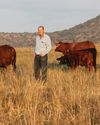कोशिश गोल्ड - मुक्त
A Bright Future Ahead For The Brahman
Stockfarm
|July 2020
For the Brahman breeders of South Africa, the challenge of breeding genetically correct animals is one they do not take lightly. They regard it as their responsibility as the benefits will not only extend to commercial beef producers, but also the entire value chain.

Their aim is to produce Brahman meat that is healthy, tender, tasty and affordable. Breeders have made it their mission to achieve this and a number of projects have been launched to bolster these efforts. This includes the ongoing Beef Genomics Project, which aims to benefit the breed and the industry at large.
Growing in popularity
Sydney Hunt, president of the Brahman Cattle Breeders’ Society of South Africa and owner of the Hunt Brahman stud near Warrenton in the Northern Cape, farms 236 breeding cows. He says the Brahman breed is in a very good space worldwide and is even expanding to Europe and Canada.
In the Unites States (US) the breed has lost some popularity as the US market requires large carcasses. This is not the case in South Africa – in fact, the breeders’ society opened separate herd books for the different Bos indicus types, so that breeders can produce animals that meet different market requirements. Despite the gruelling drought in recent years, the number of Brahman breeders increased by 5,6% and the number of stud cattle increased by almost 4 000.
Over the past 90 years, since the Brahman was introduced to the US, the breed has revolutionised beef production and cattle farming in large areas of the tropics, sub-tropics and drier parts of the world.
Good maternal traits, fertility, longevity, hardiness and hybrid vigour make the Brahman the breed of choice in subSaharan Africa. Almost 70% of cattle in Namibia has Brahman blood or are Brahman types; in Zimbabwe it is 80% and in South Africa 55%.
यह कहानी Stockfarm के July 2020 संस्करण से ली गई है।
हजारों चुनिंदा प्रीमियम कहानियों और 10,000 से अधिक पत्रिकाओं और समाचार पत्रों तक पहुंचने के लिए मैगज़्टर गोल्ड की सदस्यता लें।
क्या आप पहले से ही ग्राहक हैं? साइन इन करें
Stockfarm से और कहानियाँ

Stockfarm
Ecovite Drifos P12 and P6: Weather resistant phosphate supplements
Over 90% of South African soils are deficient in the mineral phosphorus. The country's warm, dry climate contributes to low levels of organic matter, which in turn limits phosphorus availability to animals.
4 mins
October 2025
Stockfarm
Tick resistance raises concerns
Ticks are the cause of significant annual economic losses, primarily because of the diseases they transmit. In South Africa, the blue tick species is the main culprit.
3 mins
October 2025
Stockfarm
The next generation herd health plan
<span class=
2 mins
October 2025

Stockfarm
When FMD hits: Protocols and practices
South Africa's cattle sector faces tremendous challenges regarding biosecurity and traceability. This year, the dairy industry was among the hardest hit by foot-and-mouth (FMD) disease outbreaks in most provinces in the country, especially the Eastern Cape.
10 mins
October 2025

Stockfarm
Back to basics: Success is built on simplicity and order
We live in an age of constant noise in which we are flooded daily with information and endless decisions.
7 mins
October 2025

Stockfarm
Grassland Society presents 60th congress
The 60th Congress of the Grassland Society of Southern Africa (GSSA) was recently held in Hilton, KwaZulu-Natal, drawing around 160 delegates from across Southern Africa.
3 mins
October 2025

Stockfarm
Livestock's water requirements in intensive and extensive production systems
The Earth's total water supply is estimated at around 1 386 million km³. However, only 2,5% of this comprises freshwater. Of that small fraction, approximately 68,7% is locked away in ice and snow formations in Antarctica, the Arctic, and mountainous regions.
4 mins
October 2025
Stockfarm
Breeding values level the playing field
The production of a dairy cow is influenced by factors such as age, calving season, lactation number and stage, pregnancy status, length of her previous intercalving period (ICP), nutrition, temperature, and management.
3 mins
October 2025

Stockfarm
Boost spring pastures with effective fertilisation
Applying the right nutrients to planted pastures that are tailored to the specific plant species and local environmental conditions, can significantly boost both yield and quality. However, given the high cost of fertilisers, they must be used efficiently to ensure pastures are optimally utilised by livestock. Renier Bothma, a soil scientist at Kynoch Fertilizers, explains that rainfall is a key factor in pasture production under dryland conditions. The more it rains, the greater the pasture growth and the higher the nutrient demand for maintaining optimal yield and quality.
3 mins
October 2025

Stockfarm
WHAT'S UP?
Theft burdens agricultural growth
6 mins
October 2025
Translate
Change font size

